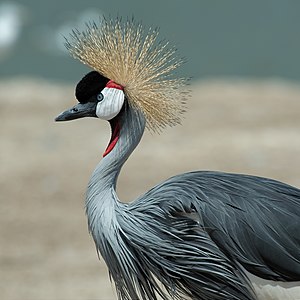Crowned cranes
| Crowned cranes | ||||||||||
|---|---|---|---|---|---|---|---|---|---|---|

South Africa crowned crane ( Balearica regulorum ) |
||||||||||
| Systematics | ||||||||||
|
||||||||||
| Scientific name of the subfamily | ||||||||||
| Balearicinae | ||||||||||
| Brasil in Wytsman , 1913 | ||||||||||
| Scientific name of the genus | ||||||||||
| Balearica | ||||||||||
| Brisson , 1760 |
The crowned cranes are a subfamily (Balearicinae) and a genus ( Balearica ) in the family of crane birds. The genus includes the crowned crane and the South African crowned crane, two species, which in turn are divided into two subspecies. The range of both species is in sub-Saharan Africa .
The populations of both crane species have declined sharply in recent decades. The stock situation of the crowned crane is given with vu (= vulnerable - endangered). The South African Crowned Crane is even classified as en (= endangered - endangered).
features
general characteristics
Crowned cranes differ from other cranes by their striking straw-yellow and tufted tufts of feathers on the back of the head. Both species also have a large bare cheek patch. The body plumage is dark slate gray or dark slate gray with a light gray neck. The wings are white and reddish brown.
One of the anatomical features of the Crowned Cranes is the long, high-set grasping toe on the back of the foot. It allows the crowned cranes to be the only species within the cranes to be able to stand in tree tops . Another feature is the straight windpipe that does not reach the sternum.
Distinguishing features of the two types
The two species differ primarily in the color of the cervical plumage, the color of the cheek patches and the size of their throat patches.
The dark crowned crane has a dark slate gray neck, which corresponds to the color of the body plumage. The cheek spot is white above and pinkish red below. The throat clumps are very small and barely developed. The light crowned crane has a light gray neck plumage that is extended to the back. The cheek spot is white and only red at the top. The red throats are strikingly red.
Distribution area and habitat
The dark crowned crane is the species further north and occurs from Senegal to the north of Cameroon to Lake Turkana and the Great Rift Valley . The distribution area of the South African Crowned Crane ranges from the Democratic Republic of the Congo, Uganda, Kenya, Central Tanzania to Mozambique and South Africa.
The habitat of the Crowned Cranes are open grasslands near the water as well as wetlands and agricultural areas.
Way of life
Crowned cranes eat seeds and grain. Their diet also includes insects, mollusks, crustaceans, fish, amphibians and reptiles.
Like all cranes, crowned cranes are monogamous and enter into permanent marriage. They live in pairs during the breeding season and in larger groups outside of the breeding season. They build their nests near the water. Usually they are erected on the ground, exceptionally it is also erected in low bushes and trees.
The clutch comprises three to four eggs. They breed between 28 and 31 days, and both parent birds are involved in the breeding business. The young birds are able to fly at an age of ten to twelve weeks.
Species and subspecies
The following types and subspecies are distinguished:
-
Crowned crane , also dark or black crowned crane ( Balearica pavonina )
- West African crowned crane ( Balearica pavonina pavonina )
- Sudan Crowned Crane ( Balearica pavonina ceciliae )
-
South African Crowned Crane or Heller Crowned Crane ( Balearica regulorum )
- South Africa Crowned Crane ( Balearica regulorum regulorum )
- East African crowned crane ( Balearica regulorum gibbericeps )
Crowned cranes and humans
Crowned cranes in European art

Crowned cranes have been depicted in European art for several centuries, indicating that they have been kept in Europe for several centuries.
One of the first paintings to depict a crowned crane is a painting by Hans Hoffmann entitled Secret Image of Emperor Maximilians von der Ehrenpforte , which was painted around 1584. The Dutch animal painter Melchior de Hondecoeter (1635–1695) depicted crowned cranes several times in his so-called “poultry pictures”. The French painter Jean-Baptiste Oudry (1686–1755) had the opportunity to study the animals of the royal menagerie in Versailles and painted crowned cranes in addition to other exotic animals.
Heraldry and national symbol
- The South African crowned crane is depicted in the national coat of arms of Uganda .
- The crowned crane is the national bird of Nigeria , but is no longer found in this country due to hunting and habitat destruction.
literature
- Mark Cocker, David Tipling: Birds and People . Jonathan Cape, London 2013, ISBN 978-0-2240-8174-0 .
- W. Grummt , H. Strehlow (Ed.): Zoo animal keeping birds. Verlag Harri Deutsch, Frankfurt am Main 2009, ISBN 978-3-8171-1636-2 .
- Carl-Albrecht von Treuenfels: Magic of the Cranes , Knesebeck Verlag, Munich 2005, ISBN 3-89660-266-7 .
Web links
- Voice of the Dark Crowned Crane on Xeno-Canto
- Voice of the South African Crowned Crane on Xeno-Canto
Single receipts
- ↑ Balearica pavonina in the endangered Red List species the IUCN 2012. Posted by: BirdLife International, 2012. Accessed September 19 2016th
- ↑ Balearica regulorum in the Red List of Threatened Species of the IUCN 2008. Posted by: BirdLife International, 2008. Accessed September 19 2016th
- ↑ W. Grummt, H. Strehlow (Ed.): Zoo animal keeping birds . P. 263.
- ↑ Treuenfels: Magic of the Cranes . P. 185
- ↑ Mark Cocker, David Tipling: Birds and People . P. 184
- ↑ Mark Cocker, David Tipling: Birds and People . P. 184

